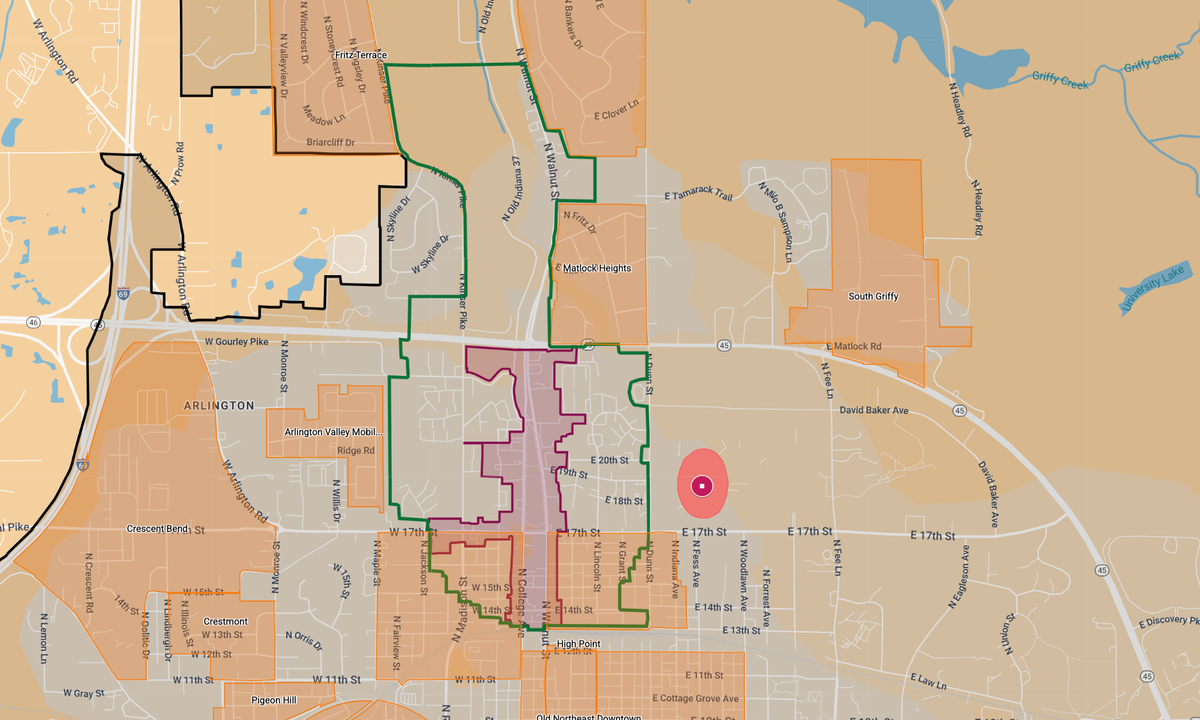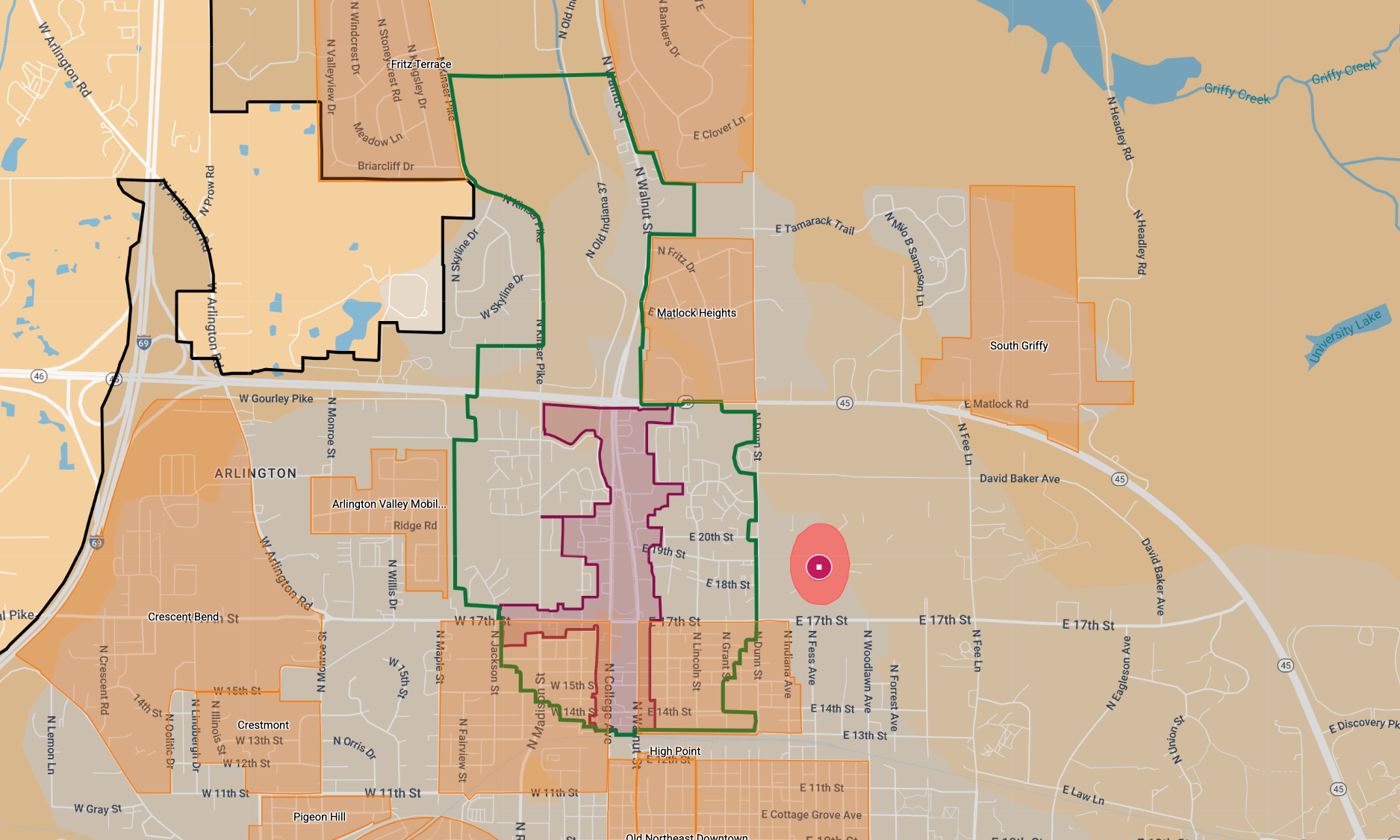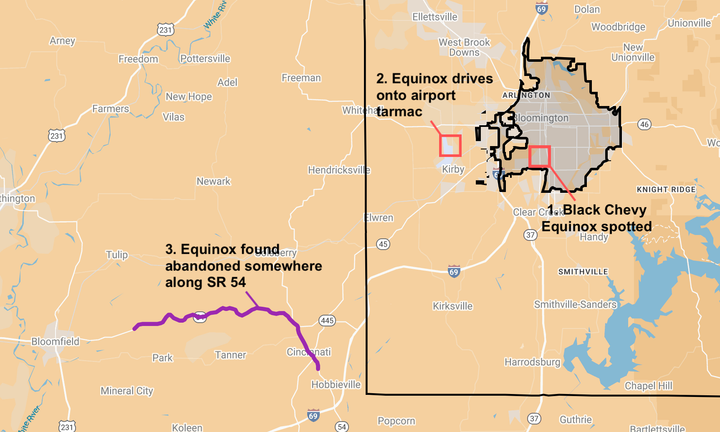City council again mulls ‘Stadium District’ as name for area around Bloomington urban wetland park, as liquor zone question looms
Returning to the Bloomington city council’s agenda for Oct. 22 is a resolution that would give an official name to a swath of territory around an urban wetland park called Miller-Showers Park on the north side of the city. If the resolution passes, the area would be called the “Stadium District.”


Returning to the Bloomington city council’s agenda for Wednesday (Oct. 22) is a resolution that would give an official name to a swath of territory around an urban wetland park called Miller-Showers Park on the north side of the city. If the resolution passes, the area would be called the “Stadium District.” There’s nothing more to the resolution than that. [Updated Oct. 22, 2025 at 10:52 p.m. The city council voted to postpone consideration of the naming resolution until its Nov. 5 meeting.]
But the resolution is related to a different proposal that has not yet appeared on a council agenda and which has not been subjected to much public scrutiny. That’s the idea of establishing a riverfront development district under Indiana state law, based on the idea that the waterway in Miller Showers Park would serve as the "river" anchoring the district.
The point of the riverfront district proposal, if enacted though an ordinance of the city council, would be that such a district allows more 3-way liquor permits (beer, wine, and spirits) than would be possible under Indiana’s population-based quota, which is 1 per 1,500 residents.
The cost of a riverfront district 3-way license would be $1,000 a year, compared to an median of $225,000 for the 15 transfers recorded for Bloomington in the most recent report from Indiana Alcohol and Tobacco Commission. Among jurisdictions with at least 10 transfers in the most recent ATC report, Bloomington’s median cost of transfer is easily the highest, with the second-ranked jurisdiction of Schererville at $165,000.
The boundaries of the riverfront development, with its plentiful and cheap alcohol permits, are limited under state law to one of a few kinds of economic development districts. Bloomington’s proposed riverfront district is part of the existing consolidated TIF district that forms the basic footprint—which essentially includes just a strip on the west side of College Avenue across the park to a strip on the east side of Walnut Street, from the SR 45/46 bypass down to 13th Street, in addition to some of the area around 17th Street west of College Avenue.
The long and short of it is that the area that allows the more plentiful alcohol permits is much smaller than the area that is proposed be named and used for marketing purposes.
Resolution on Naming
The resolution on naming previously appeared on the council’s Sept. 30 agenda, but after some discussion was postponed to this Wednesday’s meeting. And it could be postponed again, until the council meets on Nov. 5. The possibility of further delay is based on a memo from city council president Hopi Stosberg that is included in the meeting information packet.
Stosberg says in her memo that the commentary from the public on Sept. 30 led her to conclude that the boundaries of the district needed to be revised and that “targeted” outreach with a new map needs to be done.
The commentary on Sept. 30 included remarks from Gabriel Holbrow, a zoning planner in Bloomington’s planning department, who addressed the council not in his professional role but as a resident of the Maple Heights neighborhood. A quarter of Maple Heights makes up the southwest corner of the proposed “Stadium District.”
Holbrow told the council that he’s skeptical of the claim that proponents have made that “Stadium District” branding won’t affect the identity of the existing neighborhoods, including Maple Heights.
Holbrow said he considers the proposed map to split up Maple Heights and undermine the branding effort that his neighbors have made to establish the neighborhood’s identity including the refurbishment of a sign at its border.
Before Holbrow spoke from the public mic, at least two other residents of Maple Heights objected to the proposed “Stadium District.”
Sarah Alexander objected to the connection of a residential area to the university’s stadium in any way, based on its potential impact on the cost of housing and the quality of neighborhood fabric between people who live there. She put it like this, “The only result of such a connection [to the stadium] would be the further encouragement of short term rentals.” Sarah Alexander continued, “Such properties sit empty most of the year, creating hollowed out neighborhoods where it is impossible to foster relationships with the people with whom we should be able to build actual physical communities, which is to say nothing of how short term rentals inflate the cost of housing.”
Sarah Alexander continued with a criticism of the actual impetus behind the project, the increased availability of liquor permits: “Perhaps if those who are in charge of outreach on this project had consulted with someone whose eyes weren’t exclusively focused on how to ‘magic’ a drainage feature into a river, so that they could more cheaply get more drunk drivers onto a stroad, we could have avoided all of this.”
Greg Alexander echoed Sarah’s sentiments with respect to both main points—about neighborhoods and the impact of additional liquor permits into the economy of that part of town. The gateway into town should tell people that they are entering a city and that they should slow down, Greg Alexander said, contrasting that goal with the name, “Stadium District.” He put it like this: “By comparison, ‘Stadium District’ doesn’t say a thing.”
Greg Alexander continued with a critique of the notion “stadium” as part of the name: “The stadium only really exists less than a dozen days a year—I’m not alone in saying I hate it. I don’t like what those few days do for my community. I don’t want our planners and our business leaders to meditate on the stadium when they think about my neighborhood.” He added, “I live in this district, and the stadium is a problem for me, not an asset. The economic and cultural strength of this district is its thousands upon thousands of residents—and it’s extraordinarily insulting to say otherwise.”
Support for “Stadium District”
Much of the support for establishing the “Stadium District” is based not explicitly on the specific name. It’s based on the idea of the companion proposal with different boundaries, to establish a riverfront development district so that additional liquor permits can be issued to stimulate the economy in that part of the city. The west side of College Avenue across from Miller-Showers Park features two currently vacant buildings that previously housed restaurants—Colorado Steakhouse and Steak n’ Shake.
Based on the city of Bloomington’s response to a B Square records request, a proposal for a riverfront district was sent to city planning staff more than a year and half ago, in early February 2024, by Aubrey Williams, who is a cofounder of Heartwork Brewing on the west side of College Avenue across from Miller-Showers Park.
Williams spoke in favor of the “Stadium District” at the council’s Sept. 30 meeting, based on the eventual companion proposal of establishing a riverfront development district. Williams pointed to an undercount of students in the 2020 census that led to no increase in the quota of liquor permits that can be issued inside the city: “I know that additional liquor licenses can be a scary thing to consider, but when the census was done, Bloomington actually didn’t receive an increased quota…”
Williams described the impact on Heartwork Brewing: “For us, it would simply mean that we can sell local cider instead of just the beer that we make.”
Williams also spoke implicitly in favor of the name “Stadium District” when she said, “I would love to be able to explain to people where we’re located, other than just saying: Oh, we’re north of downtown, south of the bypass.”
Among the documents that the city of Bloomington produced in response to a B Square records request was a template that was created for local businesses to use in their advocacy for the name “Stadium District.” It says that the name would “drive significant economic growth by attracting new businesses, especially those related to sports, fitness, and leisure industries.” The letter continues: “The district would serve as a hub for sports-related activities, drawing in retailers, restaurants, and service providers catering to both residents and visitors.”
The letter also claims that the district could host major sporting events, presumably based on the idea the actual events would take place in facilities owned by Indiana University: “With strategic marketing, the district could host regional and national sporting events, further boosting tourism and generating additional revenue for the city.”
It does not appear that any other name than “Stadium District” was ever given consideration in the development of the proposal. The city of Bloomington denied a request from The B Square for “any records in the possession of Economic and Sustainable Development (email messages, notes, audio recordings, etc.) that document names other than “Stadium District” that were considered for the area around Miller-Showers Park.”
The city justified the denial based on the non-existence of any records: “There are no records that match your request and we are therefore unable to provide you with further information on this matter.”
After Bloomington’s director of economic and sustainable development Jane Kupersmith cancelled a scheduled interview with The B Square, asking that written questions be submitted instead, The B Square sent 10 questions. Kupersmith’s responses are given below.
Questions for Jane Kupersmith
- BSB: You say that the “Stadium District” would help hotels in their marketing, by alerting potential guests to a hotel’s proximity to the university’s football venue. However, the Indiana Memorial Union, which is not anywhere close to being included in the district, is the same 1.0-mile walk to the Stadium as Cascades Inn. Question: How can the “Stadium District” be claimed to reflect a hotel’s proximity to the football venue, when there are two hotels that are the same distance from the venue, but are treated differently as far as their inclusion in the district?
Kupersmith: Cascades Inn is included in the district. IU did not want to include IU properties (and City staff agreed that the district made sense to be off-campus). - BSB: Can you confirm that the initially proposed boundaries of the district did not include Cascades Inn and that they were expanded to include Cascades Inn due to a request from the owner of Cascades Inn? if others also made the same request, who were they, and can those requests be documented?
Kupersmith: The initial boundaries were limited to south of SR 45/46. Businesses (Not Cascades Inn but other potential “Stadium District” businesses) provided feedback that it be extended north of SR 45/46 to include the businesses in that area. I have included all the versions of maps we considered as this project evolved with and ultimately independently from a Riverfront District Alcohol Permit program. - BSB: At the time the district boundaries were under discussion, were you aware of the partisan political connections of Cascades Inn owner Mark Stoops?
Kupersmith: I am personally aware that Mr. Stoops is a former Democratic state senator but this has never been discussed in any of the meetings, outreach, or materials relating to the Stadium District, or in any other context in my work at the City. I contacted Mr. Stoops about the project--primarily focused on the relevance of the Riverfront District Permit Program. - BSB: Background. Earlier this year, the B Square made a records request for reports from Placer.ai that have been generated by city staff. Assistant city attorney Taylor Brown, who is the city lawyer who has the responsibility for responding to records requests, appeared poised to provide the requested records. Then, corporation counsel Margie Rice intervened and claimed that the records did not exist, and that Placer.ai generates only dynamic snapshots and that no requestable records get created. So the request was denied. More recently, in connection with the “Stadium District” naming effort, Rice immediately denied the request for Placer.ai records based on the claim that they don’t exist.
More background. Despite Rice’s claims about whether Placer.ai generates actual “records” that can be requested, the explicit wording in the supporting materials for the city’s contract, and city staff’s reasons for choosing Placer.ai over other competitors includes: “Unlimited exports to PDF , CSV, JPEG, SHP and KMZ in Excel, KML, Tableau, Slides,pdf and other formats for integrations, sharing, and use in business efforts.”
Question: Please describe in as much detail as you can how ESD staff actually use Placer.ai to help do their work. If no reports are ever exported, no screenshots are ever taken, and no notes are taken by staff about what they see on the screen—that is, no requestable records are created—how do staff actually manage to incorporate Placer.ai into their service to the public?
Kupersmith: I have not used placer.ai data for this project. ESD has not submitted formal placer reports for any of our council reports to date, as far as I am aware. When talking with ESD staff, we run a report with certain filters and export a map or graph or numbers. We use this when looking at event attendance or particular issues that arise. I anticipate that we will look at placer data as we are planning ahead to Kirkwood 2026, for example. I cannot speak to the PRR you are describing but include Mr. Taylor in case that is helpful. - BSB: What prevents the group of businesses that want to market themselves as being located in the “Stadium District” from simply doing that themselves with no official action by the city government (using the standard techniques like adding the district label to Google Maps, among others)? Did you consider challenging those group of business to demonstrate their own investment of time and resources, before putting your own staff time behind the effort?
Kupersmith: We are grateful when businesses self organize and self-advocate on top of the already taxing work of managing their operations. These businesses had already demonstrated commitment by self organizing, drafting memos, contacting their representatives, and working with the Chamber. Virtually all business owners and managers are burdened enough by economic uncertainty (high cost of labor, supply chain challenges, tariff impacts, general market volatility, etc.), that when we have the opportunity to support them we try to. In other words, the City’s role is to amplify, not replace, the initiative of local businesses. - BSB: How much time would you estimate that you and other ESD staff have put into the Stadium District project?
Kupersmith: I have not formally tracked hours relating to this project. There was time for meetings, time for drafting legislation and consulting with legal, writing the piece for the HT, and discussions with stakeholders. The bulk of this time is also related to the legislation for a riverfront district, which was postponed to 10-22. These two projects are interrelated but not interdependent. - BSB: Why didn’t ESD consider The B Square, or any other local media, to be a “stakeholder” for this project? Was the omission conscious and intentional or would you consider it to be a mistake? If it was a mistake, what systems will you put in place to prevent the mistake in the future?
Kupersmith: ESD has a standing column in the Herald Times, and this was an appropriate topic for that. The OOTM was contacted by WTHR to do an interview about the Stadium District. I was unable to meet during the proposed window so recommended they contact the Chamber. I do not personally consider not contacting the B-Square about this to be an omission. Typically the City issues press releases to all media outlets not to a single media provider. Outreach about this project will be ongoing. - BSB: What alternate names were considered besides the Stadium District? Dribble Creek? Cascades Corridor? Splitstone Gateway? Showers Gateway? Can you critique the alternative names—that is, can you explain why they were not considered to be as good as Stadium District?
Kupersmith: CM Stosberg might be better able to answer this. Stadium District (and of course stadium districts exist across the country--this is not anomalous) was recommended by CM Stosberg after an initial proposal for Sports District, or something similar. The preference for Stadium District came from its clarity, familiarity, and resonance with potential visitors.There were a couple of names that were floated during the May business outreach meeting, but I do not have record of them. - BSB: Who were the people involved in the naming project that you would point to as real experts in marketing and branding, whose judgement you relied on to confirm that the name “Stadium District” would be a really effective tool for achieving success?
Kupersmith: Visit Bloomington is the chief marketing expert connected to this project. They engage in branding and brand updates regularly related to Bloomington and Monroe County. They think critically about who Bloomington is as a community and how we tell our story to visitors.They endorsed this name. Adding Director Mike McAfee to the group. Desiree DeMolina, City Comms director, was also consulted. - BSB: How will you measure the success of the Stadium District naming project? Can you describe a scenario that would define failure of the naming project? (Otherwise put, what could happen in the future to cause you to conclude that the naming project has failed?)
Kupersmith: Failure could look like a lack of use or the name being leveraged in a negative way. Success in the short term will be organic. Businesses begin taking up the name. Visit Bloomington begins incorporating it into materials. We are building a long-term framework for identity, not a quick branding exercise. This name will be folded into our 2026 wayfinding audit and branding activities. We won’t likely see a visual formal rollout of this for multiple years. Creating a sense of place is a years-long effort. This moment in time is a positive one in that we can look and see what investments have already been made in and around Miller-Showers and we can appreciate the momentum that is already building while also seeing what could be possible with incremental support like naming.




Comments ()